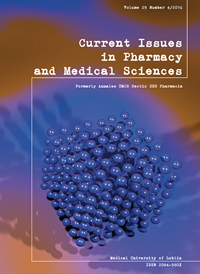The fluctuation of free amino acids in serum during acute ischemic stroke
DOI:
https://doi.org/10.1515/cipms-2016-0031Keywords:
amino acids, biomarker, ischemic strokeAbstract
Currently, little data exists regarding the involvement of free amino acids (AA) in the pathogenesis of ischemic stroke (IS). Thus, our objective was to study the degree of the degree of fluctuation of free amino acids level in serum during the acute phase of IS. The study consisted of eighteen patients (female/male: 10/8; age: 73.1 ± 4.1) with acute IS that was confirmed by way of computed tomography, while twelve sex and age matched individuals were assigned as control group. During the study period, the patients did not receive any supplemental amino acids therapy that could affect the obtained results. The venous blood was obtained after >3 hours fasting at two time-points; time-point 1 – at admission to the hospital; time-point 2 – on day 5 from stroke onset. The blood for control purposes was collected only once, and the blood collection at time-point 1 was done before thrombolytic treatment (nine patients). The amino acids were identified using the Amino Acids Analyser (AAA 400) by INGOS Corp., Praha, Czech Republic. Our results revealed a statistically significant increase of glutamate, cystine and methionine on day 1 of stroke, in comparison to control, whereas, proline level was decreased on day 1 of stroke – in comparison to control serum. On comparing day 5 to the initial day of IS, elevation was observed of levels of asparagine, glycine, tyrosine, arginine, threonine, valine, leucine and phenylalanine. It can be said, then, that ischemic stroke induces both essential and nonessential amino acid fluctuations. Moreover, the decrease in proline and glutamine serum level with the simultaneous increase in the concentration of branch chain amino acids, Glu and Thr suggests a violent mobilization of the body’s proteins. Thus, a decrease of Pro and a simultaneous increase of Glu serum level could be considered as a marker of acute IS.References
1. Brasse-Lagnel C. et al.: Glutamine stimulates argininosuccinate synthetase gene expression through cytosolic O-glycosylation of Sp1 in Caco-2 cells. J Biol Chem., 278, 52504, 2003.
2. Castillo J., Rodriguez I.: Biochemical changes and inflammatory response as markers for brain ischaemia: molecular markers of diagnostic utility and prognosis in human clinical practice. Cerebrovasc Dis., 17 Suppl 1, 7, 2004.
3. Harston, George W J et al.: The contribution of L-arginine to the neurotoxicity of recombinant tissue plasminogen activator following cerebral ischemia: a review of rtPA neurotoxicity. J Cereb Blood Flow Metab., 30, 1804, 2010.
4. Horecka A. et al.: Actylise treatment does not influence nitric oxide metabolites serum level. Pharmacol Rep, 2016.
5. Huang Y.F., Wang Y., Watford M.: Glutamine directly downregulates glutamine synthetase protein levels in mouse C2C12 skeletal muscle myotubes. J Nutr., 137, 1357, 2007.
6. Karna E., Szoka L., Palka J.A.: Captopril-dependent inhibition of collagen biosynthesis in cultured fibroblasts. Pharmazie., 65, 614, 2010.
7. Kimberly W.T. et al.: Metabolite profiling identifies a branched chain amino acid signature in acute cardioembolic stroke. Stroke., 44, 1389, 2013.
8. Kuklina E.V. et al.: Epidemiology and prevention of stroke: a worldwide perspective. Expert Rev Neurother., 12, 199, 2012.
9. Kurzepa J. et al.: Thrombolytic treatment decreases glutamate/GABA ratio in serum during acute ischaemic stroke: a pilot study. Neurol Res., 37, 934, 2015.
10. Miao Y., Liao J.K.: Potential serum biomarkers in the pathophysiological processes of stroke. Expert Rev Neurother., 14, 173, 2014.
11. Nagata C. et al.: Dietary intakes of glutamic Acid and glycine are associated with stroke mortality in Japanese adults. J Nutr., 145, 720, 2015.
12. Newsholme P. et al.: New insights into amino acid metabolism, beta-cell function and diabetes. Clin Sci (Lond)., 108, 185, 2005.
13. Phang J.M. et al.: Proline metabolism and cancer: emerging links to glutamine and collagen. Curr Opin Clin Nutr Metab Care., 18, 71, 2015.
14. Raman K., Pare G.: Of stroke and biomarkers: the elusive quest for a clinical biomarker panel. Clin Biochem., 46, 705, 2013.
15. Salemi G. et al.: Blood levels of homocysteine, cysteine, glutathione, folic acid, and vitamin B12 in the acute phase of atherothrombotic stroke. Neurol Sci., 30, 361, 2009.
16. Skovierova H. et al.: Effect of homocysteine on survival of human glial cells. Physiol Res, 2015.
17. Staszewski J. et al.: Intravenous insulin therapy in the maintenance of strict glycemic control in nondiabetic acute stroke patients with mild hyperglycemia. J Stroke Cerebrovasc Dis., 20, 150, 2011.
18. Szpetnar M., Pasternak K., Boguszewska A.: Branched chain amino acids (BCAAs) in heart diseases (ischaemic heart disease and myocardial infarction). Ann Univ Mariae Curie Sklodowska Med., 59, 91, 2004.
19. Takemoto Y.: Intracisternally injected L-proline activates hypothalamic supraoptic, but not paraventricular, vasopressin-expressing neurons in conscious rats. J Amino Acids., 2011, 230613, 2011.
20. Tom A., Nair K.S.: Assessment of branched-chain amino Acid status and potential for biomarkers. J Nutr., 136, 324S-30S, 2006.
21. Watford M.: Lowered concentrations of branched-chain amino acids result in impaired growth and neurological problems: insights from a branched-chain alpha-keto acid dehydrogenase complex kinase-deficient mouse model. Nutr Rev., 65, 167, 2007.
22. Wong, Peter T H et al.: High plasma cyst(e)ine level may indicate poor clinical outcome in patients with acute stroke: possible involvement of hydrogen sulfide. J Neuropathol Exp Neurol., 65, 109, 2006.
23. Wu G.: Amino acids: metabolism, functions, and nutrition. Amino Acids., 37, 1, 2009.
24. Wu G. et al.: Arginine metabolism and nutrition in growth, health and disease. Amino Acids., 37, 153, 2009.
Downloads
Published
Issue
Section
License
Copyright (c) 2017 Authors

This work is licensed under a Creative Commons Attribution-NonCommercial-NoDerivatives 3.0 Unported License.


